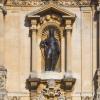South Porch, University Church of St Mary the Virgin, Oxford, 1637
Commentary
Image 1. Photo by David Nicholls, 19 March 2013. Licence: CC BY-NC 2.0.
Image 2. Line engraving by S. Bradshaw (active 1846-1870) after Samuel Read (1816-1883). Place of publication: not identified: Cassell, Petter & Galpin. Platemark 27.3 x 19.6 cm. Source: Wellcome Library no. 21356i (CC BY 4.0).
Patron and mason. This remarkable edifice was built by John Jackson in 1637 with funds donated by Dr. Morgan Owen(d. 1645). Owen was previously chaplain to Archbishop William Laud, whose approach to liturgy and ecclesiastical governance proved so divisive in England during these years; and Jackson was the master mason responsible for completing the Canterbury Quadrangle in St John’s College, built at Laud’s expense between 1631 and 1636. The two contemporaneous creations share several notable stylistic features* as well as builders and patrons; and these links help explain the troubled fate of the porch during the civil war period.
Architectural features. One of the porch’s most striking features is the pair of twisted composite columns, resembling those which support the bronze canopy over the high altar in St Peter’s Basilica in Rome. Completed by the great baroque architect Bernini in 1633, these columns may be too late to have inspired emulation in Oxford only four years later; but Bernini’s design was in turn inspired by the ‘Solomonic columns’ surrounding the altar of old St Peter’s, allegedly brought to Rome by Constantine from the Temple in Jerusalem. These columns were depicted in a cartoon by Raphael, for a tapestry destined for the Sistine Chapel, which the future Charles I purchased in 1623. Sherwood and Pevsner suggest that these may have provided inspiration for the columns of St Mary’s porch.
Even more unmistakably redolent of Catholicism was the central feature of the porch: the statue of the Virgin and Child, standing stands on a semi-gothic pedestal within a niche crowned by a shell and topped by a projecting classical pediment. As Geoffrey Tyacke has written of the whole ensemble, ‘Nothing in Oxford, or indeed in England, represents more vividly the High Churchmanship and ultramontane [i.e. Italian Catholic] artistic sympathies of the Laudian era’ (Tyack, Oxford, 112).
Wartime experience. Laud’s Puritan opponents, acutely attentive to visual language in all things ecclesiastical, were quick to take offense. Only five years after the porch was erected, Parliamentary soldiers passing through Oxford in 1642 shot off the heads of the offending statues. Two years later, the evidence of ‘popery’ levelled against Laud during his trial in 1644 included the ‘very scandalous statue of the Virgin Mary with Christ in her arms, set up in front of the new Church Porch of St. Mary’s.’
The statue of the Virgin and Child on the recently refurbished frontispiece of Oriel College was removed in 1650-1 and replaced in 1673-4.
Inside the porch, Stone included a gothic fan vault: a striking precedent for Oxford’s willingness to combine perpendicular with classical or semi-classical architectural elements which would reach its culmination in Hawksmoor’s quadrangle in All Souls.
* The segmented pediment above the porch breaks off into large volutes or scrolls similar to those above the entrance to the Canterbury Quadrangle from the Front Quad in St John’s. The ram’s heads on the bases of the columns resemble another feature of the Canterbury Quadrangle.
Sources. T. G. Jackson, The Church of St Mary the Virgin, Oxford(1897); Royal Commission on Historical Monuments, City of Oxford(1939);State Trials, ed. T. B. Howell, iv (1816), pp. 474-5; Sherwood and Pevsner, Oxfordshire, p. 285; Howard Colvin, Canterbury Quadrangle(Oxford, 1988), figs. 25, 44, 76; p. 119; Geoffrey Tyack, Oxford: An Architectural Guide (1998), p. 112.
Credit: Howard Hotson (June 2018)


